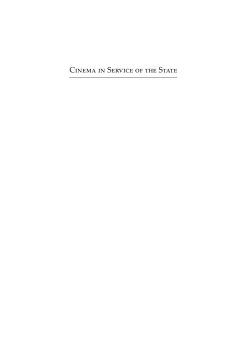
Additional Information
Book Details
Abstract
The national cinemas of Czechoslovakia and East Germany were two of the most vital sites of filmmaking in the Eastern Bloc, and over the course of two decades, they contributed to and were shaped by such significant developments as Sovietization, de-Stalinization, and the conservative retrenchment of the late 1950s. This volume comprehensively explores the postwar film cultures of both nations, using a “stereoscopic” approach that traces their similarities and divergences to form a richly contextualized portrait. Ranging from features to children’s cinema to film festivals, the studies gathered here provide new insights into the ideological, political, and economic dimensions of Cold War cultural production.
Lars Karl is a Researcher at the Leipzig Centre for the History and Culture of East Central Europe and a Lecturer at the University of Leipzig and the Humboldt University of Berlin. He has published a book on the perception of Soviet movies in the GDR and numerous articles on Russian and Soviet film history.
Pavel Skopal is a Lecturer in the Department of Film Studies and Audiovisual Culture, Masaryk University, Brno. He has edited anthologies devoted to the Czech film industry in the 1950s and local cinema history, and he has published a book of comparative research on cinema distribution and reception in Czechoslovakia, Poland, and the GDR. His current book project is focused on co-productions between East Germany and Czechoslovakia.
“Given the signal role that “the most important of the arts” (as Lenin called cinema) plays in modern society, the book’s intellectual appeal transcends the disciplinary confines of “film studies,” offering a wealth of insights into the communist experiment with a classless society.” • Choice
"Cinema in Service of the State is a valuable step towards a broader understanding of cinema in the Soviet Bloc." • Apparatus
“Lars Karl and Pavel Skopal have produced an intriguing edited volume that addresses a significant lacuna in transnational cinema scholarship.” • Historical Journal of Film, Radio and Television
“Offers valuable insights into institutions that no longer exist, yet still resemble our own present institutions with their anxious tics and politicized economic imperatives… The volume provides an appropriate reference work for anyone working on Eastern bloc media from the period.” • Studies in Eastern European Cinema
“The contributions convince not only through their analytical penetration of a difficult research area but also through conscientious dealing with the extremely rich source material.” • Fotografie und Film
“A valuable contribution to the study of cinema in Czechoslovakia and the former GDR—and a rare example of a volume that ‘looks East’ and seeks to situate these two national cinemas within the broader context of Eastern European film production as a whole.” • Seán Allan, The University of Warwick
Table of Contents
| Section Title | Page | Action | Price |
|---|---|---|---|
| Untitled | i | ||
| Acknowledgements | v | ||
| Figures | viii | ||
| Abbreviations | ix | ||
| Part I | 1 | ||
| Chapter 1. From Soviet Zone to 'Volksdemokratie' | 15 | ||
| Chpter 2. Czechoslovak Culture and Cinema, 1945–1960 | 39 | ||
| Part II | 69 | ||
| Chapter 3. ‘Veterans’ and ‘Dilettantes’ | 71 | ||
| Chapter 4. Barrandov’s Co-productions | 89 | ||
| Chapter 5. Co-productions (Un)Wanted | 107 | ||
| Chapter 6. No TV without Film | 125 | ||
| Part III | 143 | ||
| Chapter 7. Military Film Studios before 1970 | 145 | ||
| Chapter 8. Socialism for Sale | 166 | ||
| Part IV | 187 | ||
| Chapter 9. Between Magic and Education | 189 | ||
| Chapter 10. Children’s Films | 205 | ||
| Part V | 227 | ||
| Chapter 11. Decreed Open-Mindedness | 229 | ||
| Chapter 12. National, Socialist, Global | 245 | ||
| Part VI | 273 | ||
| Chapter 13. Cinema Cultures of Integration | 275 | ||
| Chapter 14. A Decade between Resistance | 315 | ||
| Chapter 15. Screening the Occupier as Liberator | 341 | ||
| Filmography | 381 | ||
| Index | 391 |
